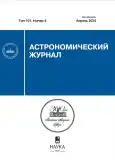МГД моделирование астрофизических и лабораторных джетов при различных конфигурациях магнитных полей
- Авторы: Торопина О.Д.1, Бисноватый-Коган Г.С.1, Моисеенко С.Г.1
-
Учреждения:
- Институт космических исследований Российской академии наук
- Выпуск: Том 101, № 4 (2024)
- Страницы: 355-365
- Раздел: СТАТЬИ
- Статья опубликована: 08.10.2024
- URL: https://modernonco.orscience.ru/0004-6299/article/view/647612
- DOI: https://doi.org/10.31857/S0004629924040066
- EDN: https://elibrary.ru/KFHWQO
- ID: 647612
Цитировать
Полный текст
Аннотация
В настоящей работе представлены результаты МГД моделирования астрофизических и лабораторных сверхзвуковых джетов при суперпозиции полоидального (Br, Bz) и тороидального (Bϕ) магнитных полей. Показано, что вылетающее вещество быстро коллимируется магнитным полем. Образуется ударная волна вытянутой формы, которая движется от мишени к границе камеры, оставляя за собой устойчивое течение. Внутри основной конической расширяющейся ударной волны наблюдается периодическая ударно-волновая структура. Показано, что тороидальный компонент магнитного поля остается в области на протяжении всего расчета и играет роль в коллимации потока. Полоидальное магнитное поле уменьшается в области конуса джета, но сохраняется в области моделирования на всем протяжении расчета и также участвует в коллимации потока. Таким образом, в коллимации потока магнитным полем принимают участие оба компонента Bz и Bϕ. Ширина джета и угол раствора конуса Ɵ зависят от величины индукции магнитного поля. По мере увеличения поля джет становится более узким, а угол раствора конуса уменьшается. Изначально мы не задаем вращение джета Ω. Однако благодаря наличию поля Bϕ вещество приобретает угловую скорость и закручивается вдоль оси z. Результаты моделирования качественно согласуются с лабораторными джетами, возникающими в эксперименте на лазерной установке «Неодим», и с ранее полученными результатами МГД моделирования образования джетов раздельно, в полоидальном или тороидальном магнитном поле.
Ключевые слова
Полный текст
Об авторах
О. Д. Торопина
Институт космических исследований Российской академии наук
Автор, ответственный за переписку.
Email: toropina@cosmos.ru
Россия, Москва
Г. С. Бисноватый-Коган
Институт космических исследований Российской академии наук
Email: toropina@cosmos.ru
Россия, Москва
С. Г. Моисеенко
Институт космических исследований Российской академии наук
Email: toropina@cosmos.ru
Россия, Москва
Список литературы
- S. Wilson and Y. Yang, 568(1), 133 (2002).
- H. L. Marshall, B. P. Miller, D. S. Davis, E. S. Perlman, M. Wise, C. R. Canizares, and D. E. Harris, 564(2), 683 (2002).
- H. L. Marshall, D. E. Harris, J. P. Grimes, J. J. Drake, et al. 549(2), L167 (2001).
- S. G. Moiseenko, G. S. Bisnovatyi-Kogan, and N. V. Ardeljan, Monthly Not. Roy. Astron. Soc. 370(1), 501 (2006).
- G. S. Bisnovatyi-Kogan, B. V. Komberg, and A. M. Fridman, Soviet Astron. 13, 369 (1969).
- G. S. Bisnovatyi-Kogan, in: Proc. 6th Intern. Workshop of the Astronomical Observatory of Capodimonte (OAC 6), Capri, Italy, September 18–21, 1991 (Dordrecht: Kluwer, 1991); edited by L. Errico and A. A. Vittone; Astrophys. Space Sci. Library 186, 369 (1993).
- D. D. Ryutov, R. P. Drake, and B. A. Remington, Astrophys. J. Suppl. 127(2), 465 (2000).
- S. Bouquet, E. Falize, C. Michaut, C. D. Gregory, B. Loupias, T. Vinci, and M. Koenig, High Energy Density Physics 6(4), 368 (2010).
- V. S. Belyaev, G. S. Bisnovatyi-Kogan, A. I. Gromov, B. V. Zagreev, A. V. Lobanov, A. P. Matafonov, S. G. Moiseenko, and O. D. Toropina, Astron. Rep. 62(3), 162 (2018), arXiv:1903.04199 [astro-ph.HE].
- O. D. Toropina, G. S. Bisnovatyi-Kogan, and S. G. Moiseenko, Astron. Rep. 67(1), 3 (2023).
- V. S. Belyaev, V. I. Vinogradov, A. P. Matafonov, A. M. Chekmarev, and A. G. Karabadzhak, Laser Phys. 16, 477 (2006).
- V. I. Mazhukin, A. V. Shapranov, M. M. Demin, A. A. Samokhin, and A. E. Zubko, Mathematica Montisnigri 37, 24 (2016).
- V. I. Mazhukin, A. V. Shapranov, M. M. Demin, A. A. Samokhin, and A. E. Zubko, Mathematica Montisnigri 38, 3 (2017).
- V. I. Mazhukin, M. M. Demin, and A. V. Shapranov, Appl. Surface Sci. 302, 6 (2014).
- Л. Д. Ландау, Е. М. Лившиц, Электродинамика сплошных сред (М.: Наука, 1982).
- V. T. Zhukov, A. V. Zabrodin, and O. B. Feodoritova, Comp. Math. and Math. Physics 33(8), 1099 (1993).
- Э. Оран, Дж. Борис, Численное моделирование реагирующих потоков (М.: Мир, 1990).
- J. P. Boris and D. L. Book, J. Comput. Phys. 11(1), 38 (1973).
- V. V. Savelyev and V. M. Chechetkin, Astron. Rep. 39(1), 123 (1995).
- V. V. Savelyev, Yu. M. Toropin, and V. M. Chechetkin, Astron. Rep. 40(4), 494 (1996).
- O. D. Toropina, M. M. Romanova, Yu. M. Toropin, and R. V. E. Lovelace, 561(2), 964 (2001).
- O. D. Toropina, M. M. Romanova, and R. V. E. Lovelace, Monthly Not. Roy. Astron. Soc. 420(1), 810 (2012).
Дополнительные файлы





















